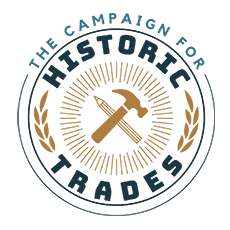As part of our mission to expand and strengthen careers in our field, the Campaign for Historic Trades is working to provide prospective tradespeople with clear career pathways and a broader understanding of the career opportunities that exist within historic preservation and historic trades. During Preservation Month, we asked team members, partners, friends, and attendees at the Preservation Trades Network’s 2022 International Preservation Trades Workshop to collaborate with us in this effort by participating in an interactive career mapping activity.
The “why” and “how” of career mapping

To create our career map, we started by dividing the field of historic preservation and trades, and the possible career options within it, into four sub-fields or categories:
Crafts & Trades: jobs that primarily revolve around the direct, hands-on work necessary for preservation of historic resources, including skilled tradespeople like carpenters or masons, as well as jobsite oriented positions like crew leader or foreman;
Planning & Management: the business side of preservation trades, including operations and project management, architects and planners, and tool/product development and sales;
Support & Development: the non-profit and government sector – cultural resource and historic property management, fundraising, and advocacy; and
Training & Education: jobs involved in inspiring and educating the next generation of historic preservation professionals and tradespeople, from workshop instructors to museum educators.
Then, we brainstormed possible job titles and career points that fell into each of these categories, and loosely arranged them from entry level to advanced. Although we couldn’t possibly represent every job that exists in the field, we tried to show a variety of examples within each category and experience level. We created a spectrum that ran from possible career beginnings (from apprentices and students to hobbyists and volunteers) to high level positions in each category (master craftspeople, business owners, and program directors) so that it would be easy to show an individual’s career path from entry to present.
By asking people to plot their careers on a map like this, we hope to eventually be able to visually represent just how diverse the field of historic preservation and historic trades actually is, and how many different jobs are required to support the goals we all work towards. We want to show anyone considering a career in historic preservation or trades just how many careers are available to them in this field, and how many different paths they can take towards the jobs they’re seeking. We also want to provide the opportunity for those already in the field to reflect on the career paths they took or are currently taking – very few of us work only in one category or move along a straight line!
Scroll through below to see a few examples of individual completed career maps (click on any of the images to view a larger version), and then download and complete your own! We’ll continue to share as we collect and archive career maps from the historic preservation and historic trades communities, so follow along for more updates to come.
Completed career map examples
Natalie Henshaw, Director of The Campaign for Historic Trades, earned her AAS from Savannah Technical College’s Historic Preservation and Restoration Program in 2013. During and after this program, she worked in hands-on preservation with various non-profits, construction companies, and federal agencies. In 2016, she founded a preservation company in Savannah, Georgia, specializing in window restoration and historic masonry. Natalie has also worked extensively in educational fields, including teaching positions and managing Lamar Community College’s Building Trades Program, before joining Preservation Maryland to lead CHT in 2021.
Moss Rudley, Superintendent of the National Parks Service’s Historic Preservation Training Center (HPTC), was passionate about historic preservation and trades early on, as a result of growing up on a working cattle farm filled with historic vernacular structures. He began his career in the masonry section at HPTC and continued to work with HPTC for 17 years before reaching his current position as superintendent in 2017.
Molly Greenhouse, The Campaign For Historic Trades’ Corps Manager, began her career with a degree in archaeology, but transitioned to historic preservation after she discovered a love for the field while working as a property history research assistant. After spending several years honing her trades skills in corps programs, as a crew leader and project supervisor for HistoriCorps, and briefly as an architectural survey investigator, Molly transitioned to nonprofit work with CHT in 2021.
Fred Aemmer, owner of Caldwell Sash Company, gained extensive experience in historic trades before becoming the owner of his current company in 1990. While continuing to work as a business owner, Fred also discovered a passion for teaching others the satisfaction that comes from completing hands on projects and worked with multiple nonprofits dedicated to training young adults in the trades, like YouthBuild and Commonwealth Preservation Trades. He has also held a variety of other positions during his 45+ year career, including working with the Kentucky SHPO.




